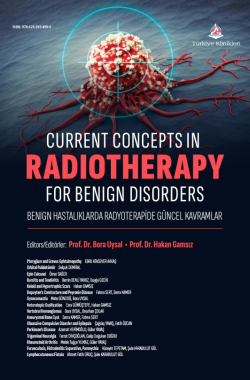Obsessive Compulsive Disorder and Epilepsia
Çağdaş YAVAŞa , Fatih ÖZCANb
aSelçuk University Faculty of Medicine, Department of Radiation Oncology, Konya, Türkiye
bEtlik City Hospital, Clinic of Radiation Oncology, Ankara, Türkiye
Yavaş Ç, Özcan F. Obsessive compulsive disorder and epilepsia. In: Uysal B, Gamsız H, eds. Current Concepts in Radiotherapy for Benign Disorders. 1st ed. Ankara: Türkiye Klinikleri; 2025. p.47-51.
ABSTRACT
Stereotactic radiosurgery (SRS) is a well-established non-invasive treatment for malignant brain tumors, but its use is increasing, especially in the treatment of non-malignant functional disorders such as epilepsy, tremor, trigeminal neuralgia, and obsessive-compulsive disorder (OCD), which are resistant to medical therapy and are inoperable. OCD is the most common psychiatric disorder treated with radiosurgery. Anterior capsulotomy via radiosurgery continues to be a valuable treatment choice for individuals with medically intractable OCD. Recent studies have shown that the frequency of seizures, especially from hypothalamic hamartomas and mesial temporal lobe epilepsies (MTLE), is significantly reduced with SRS treatment. Although the anticonvulsant effect of SRS is not clearly understood, neuromodulatory effects and ischemic necrosis of epileptic tissues are proposed mechanisms. As advances in engineering and computer-based radiosurgery planning continue, it will become even more important to define ideal neuroanatomical targets, select appropriate doses and determine patient selection criteria related to potential neurological and psychiatric disorders.
Keywords: Radiosurgery; obsessive-compulsive disorder (OCD); epilepsy
Kaynak Göster
Referanslar
- Lunsford LD. Sheehan J. Intracranial Stereotactic Radiosurgery. 2nd ed. Thime; 2016. [Crossref]
- Leksell L. The stereotaxic method and radiosurgery of the brain. Acta Chir Scand. 1951;102:316-9.
- Yamamoto M. The History of Gamma Knife Radiosurgery progress in Neuro-Oncology. 2015;22:9-18.
- Leksell L. Cerebral radiosurgery. I. Gammathalanotomy in twocases of intractable pain Acta Chir Scand. 1968;134:585-95.
- Cabrera LY, Courchesne C, Kiss ZHT, Illes J. Clinical perspectives on psychiatric Neurosurgery Stereotact Funct Neurosurg. 2019;97:391-8 [Crossref] [PubMed]
- Skoog G, Skoog I. A 40-year follow-up of patients with obsessive-compulsive disorder. Arch Gen Psychiatry. 1999;56:121-7. [Crossref] [PubMed]
- Pallanti S, Quercioli L. Treatment-refractory obsessive-compulsive disorder: methodological issues, operational definitions and therapeutic lines. Prog Neuropsychopharmacol Biol Psychiatry. 2006;30:400-12. [Crossref] [PubMed]
- Ruscio AM, Stein DJ, Chiu WT, Kessler RC. The epidemiology of obsessive-compulsive disorder in the National Comorbidity Survey Replication Mol Psychiatry. 2010;15:53-63. [Crossref] [PubMed] [PMC]
- Hirschtritt ME, Bloch MH, Mathews CA. Obsessive-compulsive disorder: advances in diagnosis and treatment. JAMA. 2017;317:1358-67 [Crossref] [PubMed]
- Lopes AC, Greenberg BD, Canteras MM, Batistuzzo MC, Hoexter MQ, Gentil AF, et al. Gamma ventral capsulotomy for obsessive-compulsive disorder: A randomized clinicial trial. JAMA psychiatry. 2014;71(9):1066-76. [Crossref] [PubMed]
- Leksell L. Stereotactic radiosurgery. J Neurol Neurosurg Psychiatry. 1983;46:797-803. [Crossref] [PubMed] [PMC]
- Rylander G. Försök med gammakapsulotomi vid ångest-och tvångsneuroser. lakartidningen. 1978;75:547-9.
- Rezai AR, Machado A, Malone DA, Greenberg B:Surgery for Obsessive-Compulsive Disorder. In: Youmanns JR, ed. Neurological Surgery. 6th ed. Philaedelphia: WB Saunders; 2011. p.1010-7. [Crossref]
- Leveque M, Carron R, Regis J. Radiosurgery for the treatment of psychiatric disorders: a review. World Neurosurg. 2013;80(3-4). [Crossref] [PubMed]
- Sheehan JP, Patterson G, Schlensinger D, Xu Z. γ knife surgery anterior capsulotomy for severe and refractory obsessive-compulsive disorder. J Neurosurg. 2013;119(5):1112-8. [Crossref] [PubMed]
- Kondziolka D, Flickinger JC, Hudak R. Results following gamma knife radiosurgical anterior capsulotomies for obsessive compulsive disorder. Neurosurgery. 2011;68:28-32. [Crossref] [PubMed]
- Banerjee PN, Filippi D, Allen Hauser W. The descriptive epidemiology of epilepsy-a review. Epilepsy Res. 2009;85:31-45. [Crossref] [PubMed] [PMC]
- World Health Organization. The world Health Report 2001: Mental Health, New Understanding New Hope. Geneva: World Health Organization; 2001. p.178.
- Fisher RS. The new classification of seizures by the international league against epilepsy 2017. Curr Neurol Neurosci Rep. 2017;17(6):48. [Crossref] [PubMed]
- Régis J. Gamma knife for functional diseases. Neurotherapeutics. 2014;11:583-92. [Crossref] [PubMed] [PMC]
- Quigg M, Harden C. Minimally invasive techniques for epilepsy surgery: stereotactic radiosurgery and other technologies. J Neurosurg. 2014;121:232- 40. [Crossref] [PubMed]
- Quigg M, Rolston J, Barbaro NM. Radiosurgery for epilepsy 2012: clinical experience and potential antiepileptic mechanisms. Epilepsia. 2012;53:7-15. [Crossref] [PubMed] [PMC]
- Batrolomei F, Hayashi M, Tmura M, Rey M, Fischer C, Chauvel P, et al. Long-term efficacy of gamma knife radiosurgery in mesail temporal lobe epilepsy. Neurology. 2008;70:1658-63. [Crossref] [PubMed]
- Bogadhabadi M, Bitaraf MA, Arans S, Alikhani M, Ashrafian H, Zahiri A, et al. Corpus callosotmy with gmma knife radiosurgery for case of intractable generalised apilepsy. Epileptic Disord. 2011;13:202-8. [Crossref] [PubMed]
- Tsuchitani S, Drummond J, Kamiryo T, Anzivino MJ, Chen ZF, Steiner l, et al. Selective vulnerability of interneurons to low dosage radiosurgery. Society for Neuroscience Annual Meeting [abstract], New Orleans; 2003.
- Ditty BJ, Omar NB, Foreman PM, Miller JH, Kicielinski KP, Fisher wS 3rd, et al. Seizure outcomes after stereotactic radiosurgery for treatment of cerebral arteriovenous malformations. J Neurosurg. 2016;8:1-7. [Crossref] [PubMed]
- Barbora NM, Quigg M, Ward MM, et al. Radiosurgery versus open surgery for mezial temporal lobe epilepsy: The randomized, controlled ROSE trial. Epilepsia. 2018;59:1198-207. [Crossref] [PubMed]
- Quiske A, Frings L, Wagner K, Unterrainer J, Schulze-Bonhage A. Cognitive functions in juvenile and adult patients with gelastic epilepsy due to hypothalamic hamartoma. Epilepsia. 2006;47:153-8. [Crossref] [PubMed]
- Wethe JV, Prigatano GP, Gray J, Chapple K, Rekate HL, Kerrigan JF. Cognitive functioning before and after surgical resection for hypothalamic hamartoma and epilepsy. Neurology. 2013;81:1044-50. [Crossref] [PubMed]
- Stabell KE, Bakke SJ, Egge A. Cognitive and neurological sequelae after stereoendoscopic disconnection of a hypothalamic hamartoma. A case study. Epilepsy Behav. 2012;24:274-8. [Crossref] [PubMed]
- Asadi-pooya AA, Sharan A, Nei M, et al. Corpus callosotomy. Epilepsy Behav. 2008;13:271-8. [Crossref] [PubMed]
- Pendl G, Eder HG, Schroettner O, et al. Corpus callosotomy with radiosurgery. Neurosurgery. 1999;45:303-7. [Crossref] [PubMed]
- Feichtinger M, Schrottner O, Eder H, et al. Efficacy and safety of radiosurgical callosotomy: a retrospective analysis. Epilepsia. 2006;47:1184-91. [Crossref] [PubMed]
- Celis MA, Moreno-Jimenez S, Larraga Gutierrez JM, et al. Corpus callosotomy using conformal stereotactic radiosurgery. Childs Nerv Syst. 2007;23:917-20. [Crossref] [PubMed]

